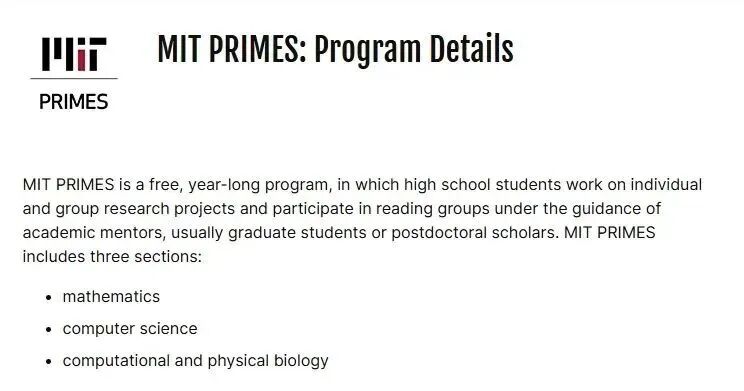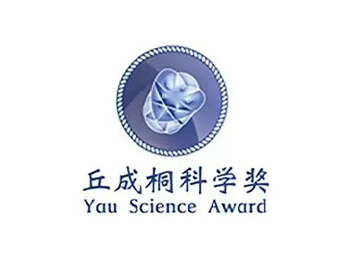MIT PRIMES 2025 Application Guide | Ivy League Back Garden Program
Sponsored officially by MIT, MIT PRIMES is a high-level academic program designed for high school students in the United States. Known as the "Back Garden" of Ivy League schools, over 40% of MIT PRIMES participants are admitted to MIT each year, and approximately 80% of its graduates receive offers from "HYPMS" (Harvard, Yale, Princeton, MIT, Stanford).
It is no exaggeration to say that students selected into MIT PRIMES have one foot halfway into Ivy League schools! If you are a high school student in the U.S., don’t miss out on this high-value flagship program! Students admitted to MIT PRIMES will complete research tasks under the guidance of MIT professors and doctoral students, and produce a research outcome. Not only can students meet outstanding peers who share similar aspirations and comparable abilities, but this research work can also be used to participate in top international scientific research competitions such as ISEF (International Science and Engineering Fair) and Qiu Shi Science Prize!
Moreover, the PRIMES program is the only channel in the world that allows cross-school teams to participate in the Qiu Shi Science Prize. Selected students have also won numerous awards at the Qiu Shi Science Prize:
So, how can one participate in this high-value program? What types of students are eligible to apply? Which students qualify for registration? Let’s take a look together below!
What is MIT PRIMES?
MIT PRIMES is a one-year free research program led by MIT. Admitted students will collaborate with MIT researchers to conduct topic selection and research focusing on mathematics, computer science, and computational biology.

Official Website Link: https://math.mit.edu/research/highschool/primes/index.php
What Benefits Can One Gain from Participating in MIT PRIMES?
- Have the opportunity to truly engage in disciplinary research in mathematics/computer science.
- Learn and collaborate with researchers from the Massachusetts Institute of Technology (MIT).
- Learn how to use computers for pure mathematics or applied mathematics research, such as becoming familiar with computer algebra systems like Mathematica, MAGMA, GAP, and SAGE.
- Meet outstanding high school students in the field of mathematics.
- Learn how to write research papers and have the opportunity to publish them in well-known academic journals.
- Have the chance to obtain recommendation letters from mentors.
- Improve one’s abilities in mathematics, reading, writing, and expression.
In addition to the above points, participating students can also directly use the achievements from PRIMES to participate in top international competitions, such as the Qiu Chengdong Science Prize, ISEF, and STS (Science Talent Search) Awards, with a high chance of winning.
In short, as a highly competitive research program, MIT PRIMES has strict selection criteria. Its overall annual acceptance rate is less than 10%, and it is known as the "shortcut to MIT".
According to incomplete statistics from the official website, approximately 80% of the program’s graduates are admitted to "HYPMS". The admission lists of top U.S. universities such as Cornell University, Carnegie Mellon University, Princeton University, and the University of Michigan all include students from PRIMES.
🌟 Past PRIMES Participants’ Admission Records (Partial):

Lists: http://math.mit.edu/research/highschool/primes/alumni.php
Therefore, when evaluating applicants, PRIMES comprehensively considers the following aspects: mathematical ability, academic background, research experience, and academic enthusiasm. Being admitted to the MIT PRIMES program is sufficient proof of a student’s outstanding ability in one of the disciplines such as mathematics, computer science, or biology.
MIT PRIMES Application Guide (Taking 2025 as an Example)
For the 2025 cycle, a new problem set will be released, and admissions will start on October 1, 2024. Applicants must solve the relevant problem set by November 30, 2024.
1. Eligible Students
Applicants must be high school students (or homeschooled students of high school age) living in the Greater Boston area, or students who can commute to MIT by car. This is because MIT PRIMES requires students to attend the campus once a week.
2. Application Process
Select Research Track
- Mathematics
- Computer Science and Computational Biology
Students can apply to both tracks simultaneously but will only be admitted to one.
Online Application
Create an online application, fill in personal information, and provide referees’ details. The system will automatically send a request for recommendation letters to the referees.
- 2-3 Recommendation Letters: It is recommended that the referees be individuals familiar with advanced mathematics or computer science, such as math teachers, counselors from math summer camps, or university professors.
Complete the 2025 Test Questions
- Applicants for the Mathematics track must solve the mathematics problem set.
- Applicants for the Computer Science and Computational Biology track must solve the computer science problem set and the general section of the mathematics problem set.
Submit Application Essay
Submit a 1-2 page personal statement, focusing on experiences in mathematics/computer learning, the types of problem-solving you enjoy, reasons for wanting to participate in PRIMES, factors that make you a strong candidate, and future plans.
3. Program Phases
Admission decisions for MIT PRIMES will be made in late January. The program is conducted in four distinct phases:

Key timelines are as follows:
- March 14: Submit a brief reading report
- June 15: Submit a mid-term research report
- Mid-October: Conference presentation
- December 1: Submit the penultimate draft of the final paper
- December 31 / January 15: Submit the final research paper





